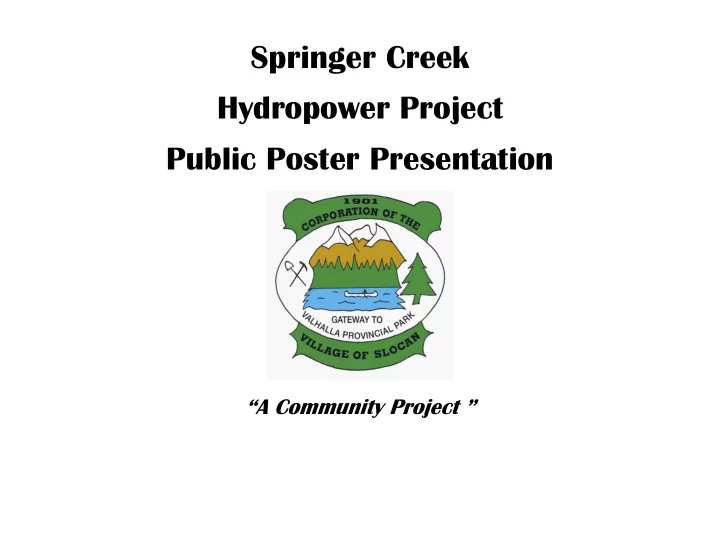

Springer Creek Hydropower Project Public Poster Presentation “A Community Project ”
The Project: • The Corporation of the Village of Slocan submitted a waterpower project application on Springer Creek in May 2010 • Engineering & Environmental studies were performed on the project site to determine project economics and environmental attributes • The proposed project configuration is based on the results of these studies, with the following summary: 800 kW run-of-river hydro 3100 MWh avg annual production Max flow diversion = 0.8 m 3 /sec Elevation drop = 130 metres Penstock pipe - 610mm diameter - 800 m long - HDPE & Steel pipe
What is Run-of-river hydro? Run of river hydropower is a type of waterpower generation that has been used throughout the world for over 100 years. A portion of a stream’s flow is diverted into a pipe that drops in elevation. The drop creates increased pressure that is used to spin a turbine and generate electricity. Once the water leaves the turbine, it is returned to the original stream. Run-of-river power typically involves a small weir structure on a creek and does not store water. Flows upstream and downstream of the project are unaltered. Significant environmental and engineering studies are performed to determine the level of allowable flow diversion.
How is the Diversion Flow Determined? A project’s Diversion Flow is determined from a balance of information collected from numerous environmental, engineering and financial studies. These include: • Historic range of water flows and relative magnitude of extremes • Species, quantity and location of fish present • Quantity and quality of fish habitat • Biological productivity of invertebrates and periphyton • Seasonal variability of water quality (chemistry, turbidity, temp & oxygen) Minimum flow recommendations are developed by scientists based on the combined results of these studies. The recommendation is reviewed and ratified by Provincial & Federal agencies.
Proposed Springer Creek Water Usage • The post project Springer Creek flows will vary Post Project Average Monthly Flow 4.5 with time of year 4 to mimic the 3.5 natural flow Average Flow (m3/sec) 3 variation Creek Flow • Winter minimum 2.5 Subject to Permitting 2 Turbine Flow instream flow 1.5 thresholds are 1 within historic 0.5 variability 0 • A proportion of Jan Feb Mar Apr May Jun Jul Aug Sep Oct Nov Dec the flow is subject to permitting review and may vary • Specialized high flow releases will also be performed in summer to ensure proper sediment transport and riparian habitat management
Springer Creek Terrestrial Habitat To assess the terrestrial habitat in and around the area, several studies were performed to develop an understanding of how the project would influence terrestrial features. These studies included: • Vegetation Inventory – terrestrial ecosystem plots • Vegetation – spring species at risk survey • Wildlife general survey • Wildlife winter tracking • Spring bird survey
Springer Creek Aquatic Habitat Based on the environmental studies, Springer Creek was found to have: • Only Rainbow Trout within the project section • Numerous fish barriers both within and downstream of the project section; limiting upstream migration • Water, benthic invertebrate and periphyton sampling indicate that Springer Creek is a relatively low productivity stream, with limited nutrients; likely due to the predominance of bedrock
Project General Arrangement 750m of new single lane access road to intake Intake – Coanda Screen Weir and sluice gate New single lane road to powerhouse Powerhouse 10m x 12m concrete & steel structure 350m of new road with buried 610mm HDPE Penstock 300m of 12 kV Powerline 125m of Surface Steel Penstock Buried Steel Penstock with new overlying road/trail to highway. Fortis BC Interconnection
Springer Creek Coanda Intake Present Intake Site: Artist's Conception:
Penstock • To minimize impact and better accommodate the rocky narrow canyon at the intake, the upper 300m of the penstock will use more flexible HDPE pipe which will be constructed within the access road fill • The above ground penstock section will be steel pipe constructed in a narrow corridor on pedestals using a highline system • The lower buried section from above the highway to the powerhouse will be steel pipe buried in a trench or within a raised fill • The steel sections will be constructed using ring clamps to minimize equipment requirements and construction time
Public Recreation - The Project will not impact the canyon trail usage - some access control is required within the project construction zone to ensure safety - A new trail would be created along the lower penstock route linking the Village park/campsite to the highway and canyon trail - fish habitat and population abundance will be maintained, ensuring continued usage for any recreational fishing
THANK YOU FOR ATTENDING OUR OPEN HOUSE Please take the time to fill out our questionnaire, we value your opinion. For additional questions: Email: cao@villageofslocan.ca
Recommend
More recommend